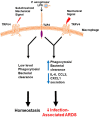The Role of TRPV4 in Regulating Innate Immune Cell Function in Lung Inflammation
- PMID: 32676078
- PMCID: PMC7333351
- DOI: 10.3389/fimmu.2020.01211
The Role of TRPV4 in Regulating Innate Immune Cell Function in Lung Inflammation
Abstract
Ion channels/pumps are essential regulators of innate immune cell function. Macrophages have been increasingly recognized to have phenotypic plasticity and location-specific functions in the lung. Transient receptor potential vanilloid 4 (TRPV4) function in lung injury has been shown to be stimulus- and cell-type specific. In the current review, we discuss the importance of TRPV4 in macrophages and its role in phagocytosis and cytokine secretion in acute lung injury/acute respiratory distress syndrome (ARDS). Furthermore, TRPV4 controls a MAPK molecular switch from predominately c-Jun N-terminal kinase, JNK activation, to that of p38 activation, that mediates phagocytosis and cytokine secretion in a matrix stiffness-dependent manner. Expanding knowledge regarding the downstream mechanisms by which TRPV4 acts to tailor macrophage function in pulmonary inflammatory diseases will allow for formulation of novel therapeutics.
Keywords: MAPK; TRPV4 (transient receptor potential vanilloid-4); innate immunity; lung inflammation and injury; macrophage.
Copyright © 2020 Scheraga, Southern, Grove and Olman.
Figures

References
Publication types
MeSH terms
Substances
Grants and funding
LinkOut - more resources
Full Text Sources
Medical
Research Materials
Miscellaneous

